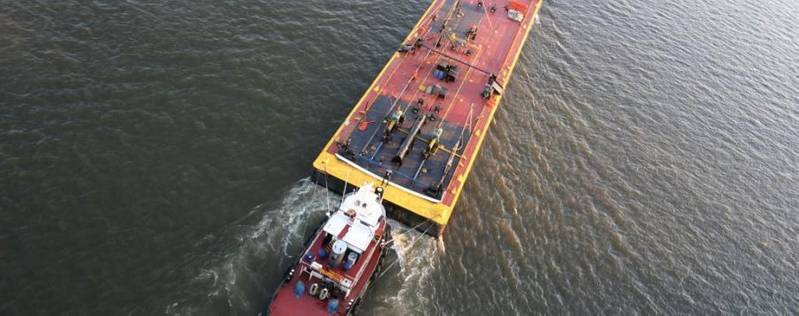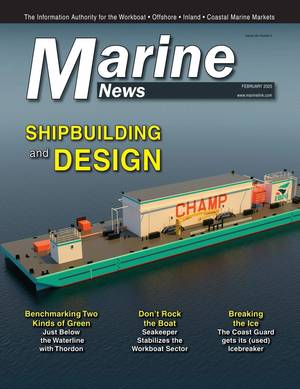St. Louis Regional Freightway: Prepare now for Lock Closures
Lock Closures Starting on the Illinois Waterway This Summer May Result in More Freight Flowing Through St. Louis Region.
Businesses that move or handle commodities on the Illinois Waterway system are being encouraged to start making alternative plans due the scheduled closure of locks on that inland waterway system. With a two-week closure planned by the U.S. Army Corps of Engineers beginning as early as August 2019 and closures of 90 to 120 days expected in the summers of 2020 and 2023, shippers will need to either find alternate routes for the millions of tons of commodities that typically move along the Illinois River during these time periods or to concentrate on shipping outside of the closure windows. One of those alternative routes is the Mississippi River which flows through the St. Louis metropolitan region. The St. Louis region could see an increase of commodities rerouted through its world-class freight network which is home to the nation’s most efficient inland waterway port and provides minimal rail congestion and quick truck-turns.
Six of the eight locks on the Illinois Waterway system are scheduled to undergo major infrastructure repairs, in order to sustain a navigable connection between Lake Michigan and the Mississippi River, just north of St. Louis, Missouri. Through cooperation with the navigation industry and Illinois Waterway system stakeholders, the U.S. Army Corps of Engineers Rock Island District has developed plans for the simultaneous closure of multiple locks that will provide time for much needed critical repairs and maintenance, while reducing impacts to navigation. Impacts can further be reduced if advance plans are made by barge lines, shippers and business owners along the waterway.
Nearly 30 million tons of commodities a year move through the southernmost and busiest lock on the Illinois River -- the LaGrange Lock and Dam in Versailles, Illinois. That is the federal facility in most urgent need for major rehabilitation and repair, as well as the primary driver for the whole coordinated closure that prompted the improvements over all six locks that will be closed for 90 to 120 days between July 2020 and October 2020. During the scheduled closures, no vessels will be able to pass through the affected locks. An exception to this restriction could occur at the LaGrange and Peoria Locks if water levels become high enough that the wicket portions of the dams could be lowered for open-pass. This would allow vessels to pass over the wicket dam without using the lock.
While the bulk of the work will not get underway until summer 2020, the industry will get a taste this summer of what to expect in 2020 and 2023, as the Starved Rock Lock & Dam in Ottawa, Illinois, and the Marseilles Lock and Dam in Marseilles, Illinois, undergo partial closures in June and July, with full closures scheduled from August 16 to August 30, 2019.
“It’s vital that industry members are aware of the plans, the timing and any steps they need to take in advance of the closures to help minimize the disruption to their operations or, to potentially be a part of the solution,” said Mary Lamie, executive director of the St. Louis Regional Freightway, which is working to raise awareness about the lock closures. “Shippers already route freight to the St. Louis region where the exceptional freight network means they benefit from lower distribution and logistics expenses and shorter travel times. We should have the capacity to take on more and be a part of the solution for those who will be impacted, if the planning starts early.”
Mike Toohey, President and CEO of Waterways Council, Inc., said what actually will happen to commodity movements during the closure is the great unknown. “Plan, be flexible and be ready,” Toohey said.
The companies, farmers and manufacturers who need to move raw materials and freight during this period need to make arrangements now because, based on their plans, the rest of the freight industry may need to adapt. Given that a standard barge tow carries the equivalent of 1,070 truckloads or 216 railcars, questions arise as to where the trucks and the drivers will come from and whether there will there be enough railcars. Early planning by the companies that will need those trucks or rail cars is essential. Alternatively, there is a fear that nothing will move during the shutdown periods, by any mode. The economics of shifting cargo flows to alternative modes may not enable goods to be transported cost competitively, as transfer and storage capabilities could be challenged to provide the market needs in both the geographies of supply and demand.
Marty Hettel, Vice President Government Affairs at American Commercial Barge Lines (ACBL), and Chairman of the Inland Waterway User Board through May 27, 2019, says closures of 90 to 120 days for maintenance are common on other waterways in the winter, so the industry is used to closures and works around them. The challenge, he notes, is that such closures on the Illinois Waterway are unprecedented, so the industry does not yet know what the workarounds will be.
Each year, more than 10 million tons of corn and soybeans transit through the LaGrange Lock bound for export. Other non-agriculture products being moved through the Illinois Waterway system locks range from chemicals and petroleum products to raw materials for steel mills and related outbound product, ethanol, cement and styrene.
Hettel said he believes some shippers will accelerate shipment timetables and move their commodities by barge in advance of the closure, or simply wait until after the closure to move them, but those timing shifts will require planning. The industry will need enough barges on hand to store and load up in advance so they can be staged above the closure to carry them through and meet demand. Finished product can be loaded on emptied barges and take advantage of “floating storage” until it can be moved. Some critical commodities, such as ethanol, will have to move by truck or rail to points outside the locks since it can’t be stored or put in a pipeline. He adds that some of the agriculture product may go on unit trains to St. Louis to ship down the Mississippi River for export or go to terminals below the LaGrange Lock, but much will depend on the price for agriculture commodities. Liquid chemical shippers may be most impacted, as those products cannot sit as long in a barge. While some will look to rail or truck options to keep their plants going during the closure, others may schedule their own plant maintenance during the same timeframe. Hettel anticipates that in advance of the closure, there will be an increase in production at the cement companies in Missouri that ship to Chicago.
But he said he is confident the freight system has the capacity. “Certainly, we have the capacity on the river. I’m not as familiar with rail,” said Hettel. “The key message is it’s better to plan for a closure than to deal with an unexpected outage. It gives flexibility to the folks in the St. Louis area to possibly take tonnage that would have moved by barge and accept it at their facilities and potentially ship it by rail instead.”
Scott Sigman, Transport and Export Infrastructure Lead for the Illinois Soybean Association, says an average of 16 million tons of soybeans move though the locks annually. He said there are 64 terminals all around the State of Illinois that handle soybeans, and 19 of those are on the Illinois River. But there are potential alternative routings. There are 40 shuttle rail facilities in the state, moving west, east and south toward New Orleans. He also points out the containerization option that currently moves about 10 percent of the soybeans by rail to coastal ports, noting it is a great alternative for accessing international markets which do not want to buy as much in bulk.
“Leveraging the flexibility of different directions and the wide range of modes available, soybean farmers have some options,” Sigman said. “Some have storage. Some can store everything for a year, but many will have to take their commodities somewhere. The facilities south of LaGrange and in the St. Louis region will be busier than a one-armed paper hanger. They will be a priority destination, but they’ll be able to manage that through the pricing mechanism.”
Because of the sheer volume, Sigman anticipates a surge in advance of the closure and likely backfilling the elevators slowly and using them as storage, then another smaller surge after the system is reopened. He said he believes the 15-day closure this summer will be a key learning experience to see how the freight system and the industry responds.
Questions concerning the lock closures on the Illinois Waterway system may be directed to [email protected] or 309-794-5729.

















